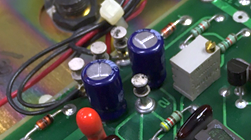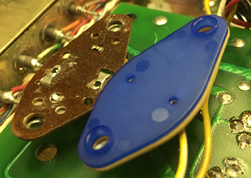Backup Includes Audio Processing

[September 2024] It always seems like whenever everything is running right, some unexpected problem – or a disaster – is getting ready to unleash chaos.
Every time a storm approaches – or a major fire – stations immediately think about what can happen at their studio or transmitter sites.
Loss of power is a common problem, and stations committed to serving their community usually have a generator ready to take the load. Surviving a lightning strike, a power surge, or flood can each unleash a whole series of issues that can take a station down momentarily – or for days at a time. Having a backup plan is essential, is it not? Dead air – or no carrier – is no fun at all.
So, it might not be a surprise to arrange for a backup transmitter or a studio (during major disasters, like Katrina, sometimes stations offer studio space to a competitor so they can stay on), have you given thought to what you can use if your audio processor has problems?
The answer just might be on the shelf in the back, or at the transmitter building.
BACKUP
It has been said that a wise person plans for the worst but hopes for the best. So, it is clear that having a plan in place will make it much easier to keep the signal on the air no matter whether it is a local power bump or natural disaster.
Once a backup program and/or transmission system is in place, attention can be given to hardening them again against failure. For example, in order to survive the elements, proper grounding is a given. The use of ferrite rings on data, audio, composite, control, AC, and RF hardline are necessary. A tower strike can send thousands of Volts to your transmitter via the RF line. Ferrite rings at the transmitter’s RF output is good for the rig and all related equipment.
On the other hand, input/output devices get injured. There is nothing more telling than rainbow discoloration around a composite BNC output to show the path the surge has taken. AC line strikes are handled by power diodes, power chokes, and large MOV’s across facility power. Senior broadcast engineers know this.
Unfortunately, often GM’s require shrapnel proof left on their desk.
BACKUP GEAR NEEDS ATTENTION
No one in their right mind would let a backup transmitter or generator site for years without testing, to make sure it will work when needed.
Just like a four-wheel drive vehicle is essential during an emergency, if there is no air in the tires, you are not going anywhere. Ditto with backup gear that is not ready to go.
Over time, batteries lose their charge, capacitor values can diminish, controls can become intermittent, with the switches needing flushing to ensure proper contact. All these are things the careful engineer will be checking regularly.
AUDIO TOO
So then, you have power, you have a backup studio, you have staff – but what happens if that great digital audio processor gets hit and suddenly sounds like little robots are chocking it?
Analog can be very good. Possibly you have noticed many plug-ins attempt to let digital audio imitate analog, whether emulating tube characteristics or what some call “natural waveforms.” Yet, you may have exactly the best solution in your storage area. I share this information with you like a good assistant. As audio processing has become rack-mounted computers, stations are budgeting to replace audio processing more often.
I recently left Orban and have established a company to service some great analog processors – the 9100, 8100, and XT2 models. Why these models? The 9100 is analog, the first NRSC 6-Band. People like the sound. The 8100 is analog, the first 2-Band FM. People like the sound. The XT2 is analog, the first 6-Band for use with the 8100. Perhaps you might notice a pattern here.
It is true: People really do like the sound of these analog models. They are great off-line backup for serious stations in major markets and are still main units for many top-rated stations in storm regions.
A few diehard fans in Hawaii, New Mexico, and Florida have even replaced more recent digital processors with the 8100 or 9100s, to the delight of their listeners.
KEEPING THE SOUND ALIVE
As some of you may know, I do refurbs and focused repairs for these great analog processors.
Having worked for Orban for some 17-years has given me insight into a number of facility problems, like surges entering a BNC composite output connector, leaving zap marks toward the analog/digital inputs. Other times zap marks run across the board hitting the front panel.
I call these the full NASCAR.
MAKING THE ANALOG AUDIO SING
Refurbs include regulator sockets, power caps, coupling caps, controls, switches, noisy IC’s, burnish edge connectors, calibrate band gain, vibration test cards and chassis.
There are some folks who like to do this on their own, but there are reasons to have a “factory rehab” done – and it is not all that expensive, unless your personal time is free.
Even if you discount your own time, you would not want to spend time finding and inserting exact replacements. This is sort of a warning to do-it-yourselfers – because many parts are no longer available or newer ones have better results.
For just one example: I use 100 uF at 63V capacitors instead of the 47 V at 35 V in the original design manufacture.


TESTING AND ENSURING PERFORMANCE
After making repairs and upgrades, I set the units to drive a Part-15 FM transmitter for a few days.

While watching the unit’s operation, I use detected audio to feed an XY scope; AM units feed an oscilloscope as well, monitoring the clipping points and modulation peaks.When finished, a full sweep of the output is done to record bandwidth and low distortion.
Then the processor is ready to go back on the air or in standby mode as needed.
If you have an 8100 or 9100 sitting on a shelf because it had aged out or because you bought the latest digital thingy, seriously consider how having a great backup processor in case of need.
Analog processing used to sound great. It still does!
– – –
Leembruggen Audio Service is now located in Kingman, AZ. Robert is happy to give you a quote on making an 8100 or 9100 as good as new … or better. Contact Robert at 602-510-5800 or robert@leembruggen.com
– – –
Would you like to know when more articles like this are published? It will take only 30 seconds to click here and add your name to our secure one-time-a-week Newsletter list
Your address is never given out to anyone.
– – –
